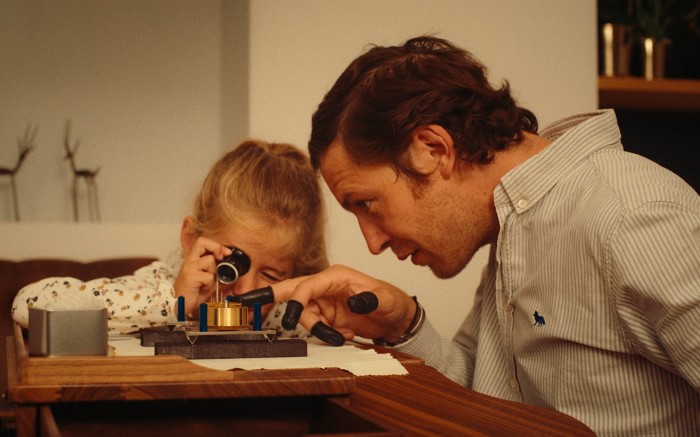The Maison Alcée high-end clock kit teaching the art of horology at home

Roula Khalaf, Editor of the FT, selects her favourite stories in this weekly newsletter.
The innermost workings of a mechanical timekeeper can remain a mystery even for hardened horophiles. But, for those moved to discover just how a clock functions, there is one sure way of finding out: by making one.
The market for “clock making kits” is now wide ranging. At one end of the DIY scale, there are transparent plastic efforts costing less than £15, and £50 wooden examples in the shape of owls. At the other end, Munich-based company Uhrenbausatz will sell you a home-build Mechanica wall clock kit for €5,000 that fits together and works so smoothly that people will find it hard to believe you constructed the timepiece yourself.
Tell us what Watches & Jewellery content you want to read more of

🔗 Take part in the reader survey to help us shape our future coverage and enter a free prize draw.
However, during last year’s Grand Prix d’Horlogerie de Genève — the Oscars of the watch world — a new type of home-build kit beat the established ready-made creators, such as L’Epée 1839, Matthew Norman and even jewellers Van Cleef & Arpels, to scoop the prize for the best mechanical clock.
The Persée Azur is one of a current series of three clocks from a young French company called Maison Alcée that cost between €5,500 and €6,900 apiece and arrive in a handcrafted wooden box containing 233 components and 17 watchmaking tools.
It also contains a beautifully presented 150-page book that not only guides the maker through the construction process but explains, in detail, the centuries-old craft of clockmaking. Those purchasing the Persée will also receive a signature plate engraved with their initials, which can be placed on the dial of the table clock.
Maison Alcée is the brainchild of 32-year-old mother-of-two Alcée Montfort, who discovered her inherent understanding of mechanics as a youngster when she realised she “loved to make things by hand”.

After studying physics at university, Montfort landed a placement in the workshops at Hermès, where she devised scientific solutions to problems encountered by artisans working with silk and leather.
Next, she worked in supply chain management for Cartier, and then in a Paris-based restoration workshop run by the Richemont luxury conglomerate before moving on to run Tag Heuer’s movement assembly workshop in 2017 — at the age of 25.
But, when the first of her children was born in 2019 and her husband’s work took the family to Reims, in France’s Champagne region, Montfort decided to act on the idea of creating a business making high-end clock kits.
“My goal is to pass-on the heritage of craftsmanship, especially watchmaking, which is an absolute mystery to most people,” she says.
“I have always been sure that the best way for someone to demystify it is to assemble their own movement, because that is the only way they will be able to understand the role of every component.”
The business was three years in development before the first 50 clocks became available in 2023 — all of which sold out during the year. For 2024, the number of kits available for sale is expected to double.

Each one uses a large-scale regulator watch movement, especially designed for the kits through a collaboration between French master watchmaker Thierry Ducret, Swiss timepiece designer Antoine Tschumi, and watch horology professors from the prestigious Ecole de Morteau in the French Jura.
All the parts are made in the French and Swiss Jura mountain regions by 38 different fabrication partners before being delivered to Montfort in Reims, where she, with the help of her husband, combines them into the individual kits.
“The movement was specifically developed so that it can be assembled by anyone who is sufficiently patient, able to follow directions and reasonably dexterous,” says Montfort.
“But it isn’t like Lego or Meccano where you build it and it’s done — the thinking behind it is that, by assembling the clock, you gain knowledge.”
To complete the clock — which can be finished in vertical or horizontal configurations — takes about 10 hours of concentrated work.
But Montfort’s intention is that buyers should put it together in gentle stages, taking breaks to understand each set of components and making the most of the fact that one of the enjoyable aspects of the project is that it provides welcome relief from constantly connected lives.
“People become so focused on building the clock that they become lost in another world, almost like children — and, when the regulator goes in towards the end and the movement comes to life, it is always an amazing moment.”
Even if you balk at the idea of assembling an item of flat-pack furniture, or remember struggling to build model aeroplane kits as a youth, do not be put off: Montfort can supply a step-by-step video with every Maison Alcée clock — and, if anyone really does get stuck, expert help is only a phone call away.
The tools supplied with each clock are of the type made for apprentices to avoid components getting scratched or damaged and, for those who really want to take it seriously, Maison Alcée sells a watchmaker’s bench for an extra €1,000.
Then, once a clock is completed, the proud builder can enhance it with an optional chiming function — or take it all to pieces, and start again.
Comments